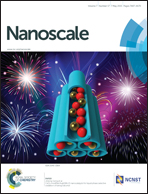Nanodrop on a smooth solid surface with hidden roughness. Density functional theory considerations
Abstract
A nanodrop of a test fluid placed on a smooth surface of a solid material of nonuniform density which covers a rough solid surface (hidden roughness) is examined, on the basis of the density functional theory (DFT), in the presence of an external perturbative force parallel to the surface. The contact angles which the drop profile makes with the surface at the leading edges of the drop are determined as functions of drop size and perturbative external force. A critical sticking force, defined as the largest value of the perturbative force for which the drop remains at equilibrium, is determined and its dependence on the size of the drop is explained on the basis of the shape of the interaction potential generated by the solid in vicinity of the leading edges of the drop. For even larger values of the perturbative force no drop-like solution of the Euler–Lagrange equation of the DFT was found. The upper bound of the inclination angle of a surface containing a macroscopic drop is estimated on the basis of results obtained for nanodrops and some experimental results are interpreted. The main conclusion is that the hidden roughness has a similar effect on the drop features as the traditionally considered physical and chemical roughnesses.


 Please wait while we load your content...
Please wait while we load your content...